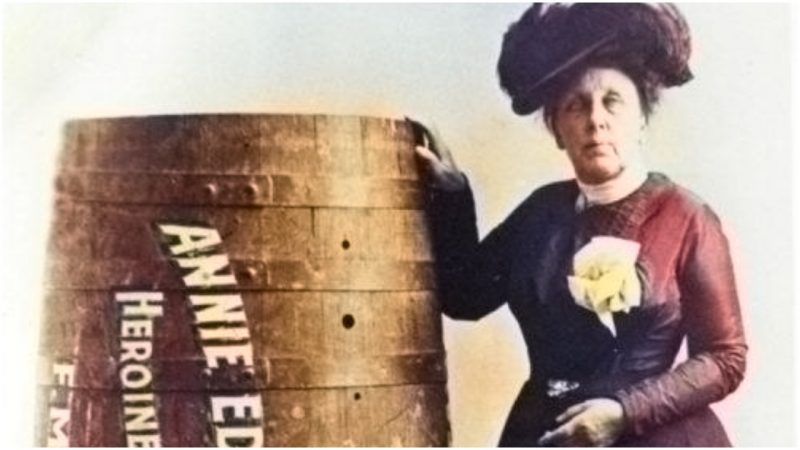Talk about a risky retirement plan. In 1901, a destitute, widowed teacher decided to try to make her fame and fortune by becoming the first person to survive a tumble over the Niagara Falls in a barrel. Though she was reluctant to admit her age, she took the plunge on her 63rd birthday. Alas, the stunning feat did not result in the hoped-for waterfall of cash, and she died 20 years later, flat broke.
Anna “Annie” Edson was born in Lockport, New York, in 1838, not 20 miles from Niagara Falls, one of eight children in a well-off family. After a four-year training course (a sort of precursor to college), she became a schoolteacher. She met and married David Taylor, with whom she had one boy, who died in infancy. Shortly thereafter, David Taylor died in the Civil War, leaving Annie totally on her own.
The next chapter of Annie Edson Taylor’s life was remarkable on its own, especially for a woman in that era. She crisscrossed the country in search of a livelihood, settling first in Bay City, Michigan, where she opened the town’s first dance studio, and then in Sault Ste. Marie, where she taught dance and music. She later tried to find work in San Antonio, Texas, and Mexico City. At one point during these adventures, she was traveling in a stagecoach held up by the Jessie James gang. Luckily, she had sewed her cash in the hem of her dress.
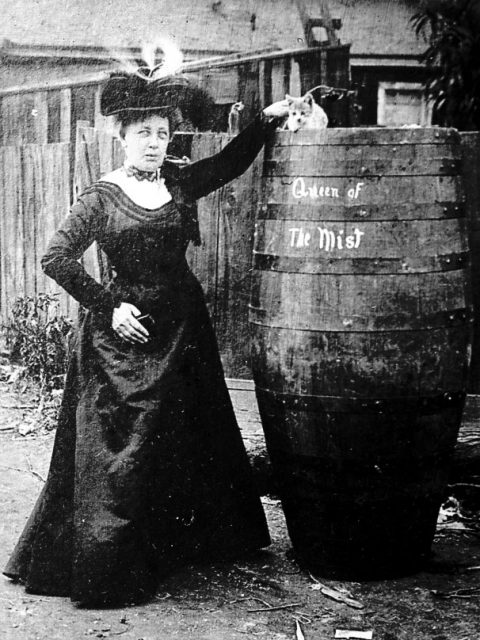
At the turn of the century, Annie Edson Taylor knew she wasn’t getting any younger and earning a living was becoming difficult. She needed a way to make some money to secure her later years. An avid reader of newspapers and popular magazines, she’d observed the popularity of daredevil stunts. And she noted that the 1901 Pan-American Exposition, a World’s Fair, would be held in Buffalo, not far from her home turf of Niagara Falls. It would attract scores of tourists. Swimmers had swum the cold waters; tightrope walkers had crossed over them; barrel riders had shot through the currents below.
“I had lost $8,000 some years ago in Chattanooga and my classes in dancing and physical culture did not bring in money fast enough to suit me,” she told a local newspaper at the time. “I looked around for something that nobody had ever done before as a means to make some money. … The idea of going over Niagara came to me in an instant, and I studied the conditions fully before I embarked on the trip.”
Taylor chose to make the ride in a pickle barrel around five feet tall and three feet wide, made of white oak slats held together with iron rings, and stuffed with a mattress meant to cushion the blow of falling over the Falls. A 200-pound anvil was placed at the bottom for ballast.
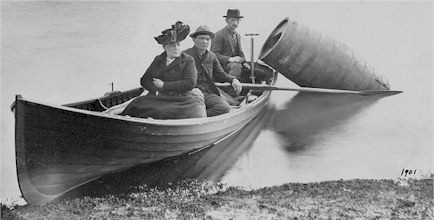
It was remarked at the time and later that she seemed a very positive person, and determined to survive and make some money from this feat.
Two days before Taylor herself went over the Horseshoe Falls, she tested her vessel by sending over a cat. The startled feline survived with only a minor cut, and deigned to pose atop the barrel for a photograph with Taylor smiling along side.
Fearful of her safety—not to mention their culpability—some of the people she was counting on for their assistance tried to talk her out of the stunt even as they helped her. If she were to die, her manager, Frank M. Russell, was warned he could be prosecuted for manslaughter. Others felt queasy over their seeming assistance in a suicidal mission. Her crew members delayed the plunge several times, attempting to talk her out of it. Indeed, the stunt was first planned for October 23rd, but winds were high and the currents too rough, and her crew balked at taking her out.
Nevertheless, at 14:00 on October 24, Taylor climbed into her barrel. A bicycle pump was used to compress the air, and a cork plugged into the hole. Her crew got into their boat and tugged the barrel out into the Canadian currents of the upper Niagara River. Several thousand people had gathered to watch her barrel tumble over the 167-foot falls.
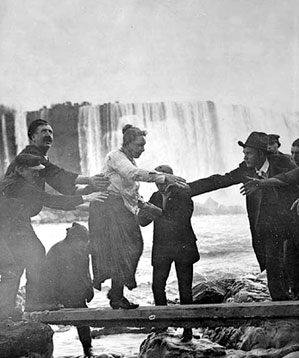
Though various newspapers reported her age as anywhere between 42 and 50, October 24, 1901, was actually Annie Taylor’s 63rd birthday.
“Mrs. Anna Edson Taylor, the Bay City, Mich., woman, successfully went over the Horseshoe Falls in a barrel yesterday, thus accomplishing the greatest and most daring feat of any ever attempted in this locality,” according to an article in the Wellsville [New York] Daily Reporter, on October 25, 1901. “She is the first and only human being who has made this fearful leap over the falls and lived to describe it.”
Twenty minutes after being let go in the Niagara River, Annie Edson Taylor was pulled out of her barrel, mostly unharmed, if “slightly hysterical” per newspapers of the day.
“Not only did she survive, but she escaped without a broken bone, her only apparent injuries being a scalp wound one and one-half inches long, a slight concussion of the brain, slight shock to her nervous system and bruises about the body,” the Boston Journal reported on October 25, 1901. “She was conscious when taken out of the barrel. The doctors in attendance upon her tonight said that, though she was somewhat hysterical, her condition is not at all serious and that she probably will be out of bed within a few days.”
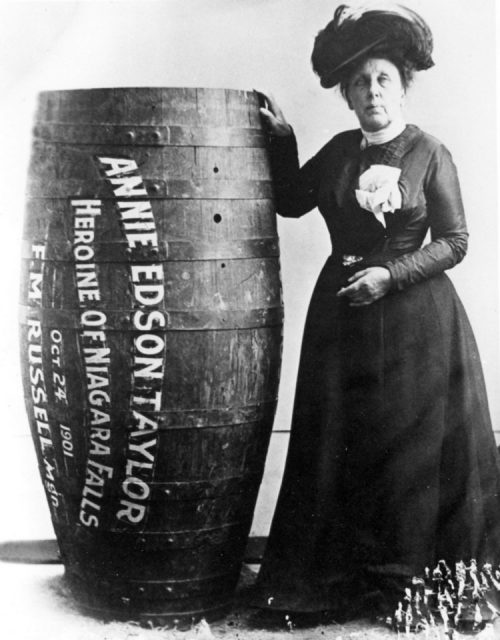
That said, the big fall definitely shook her up. The first thing she said, as recounted by many newspapers, was “If it was with my dying breath, I would caution anyone against attempting the feat…. I would sooner walk up to the mouth of a cannon, knowing it was going to blow me to pieces than make another trip over the Fall.”
While the stunt did give her a measure of notoriety in the form of numerous stories and photos, fame was fleeting and fortunes did not follow. Her manager ran off with the barrel, an important prop for her imagined speaking engagements, never to be seen again. She spent her final years at a tourist stand with a replica of the barrel charging people to pose for photographs.
Going over the Niagara Falls in a barrel remains a bad retirement plan: 15 people have attempted it since Taylor’s successful plunge; five have died. Today it is illegal, and an attempt would result in a $25,000 fine.
When Annie Edson Taylor died in 1921 at the age of 82, she was as broke as she’d feared all along. A group of friends took up a collection to have her buried in a section of a Niagara Falls (New York) cemetery alongside a small group of fellow “stunters.”
Her gravestone reads: FIRST TO GO OVER THE HORSESHOE FALL IN A BARREL AND LIVE.
